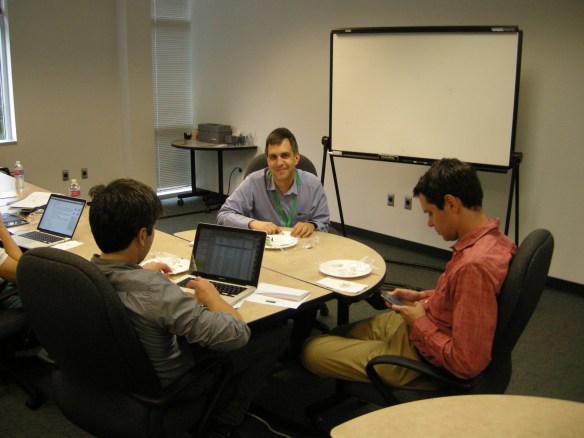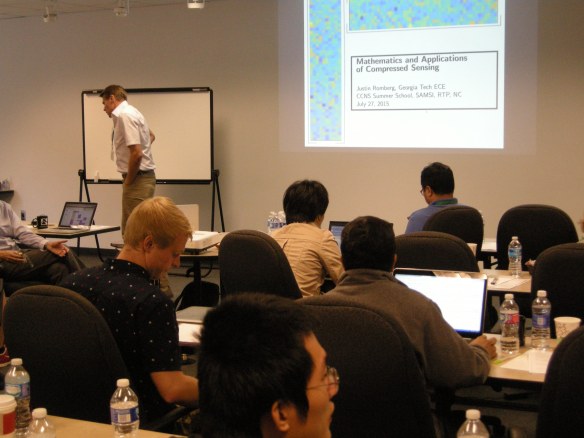This week’s blog entry is written by SAMSI’s Kenan Fellow, Alexandra Solender who is the Science Department Chair at Holly Springs High School and teaches AP Physics C, Honors Physics. She is also the Science Olympiad Coach and SNHS Advisor.
During the week of July 27th, SAMSI hosted a Computational Neuroscience Summer School in which I was lucky enough to participate. The workshop was aimed at researchers in areas such as neuroscience, computer science, applied mathematics, and biomedical engineering as it covered research topics like pattern theory, signal processing, and functional and structural imagining. This opportunity was extremely exciting for me as I am a high school physics teacher not a math or science researcher. I have been working with Dr. Tom Witelski at SAMSI since the beginning of June through the Kenan Fellows Program. The Kenan Fellows Program selects K-12 teachers in North Carolina to work with university or industry experts during the summer to gain real world experience to bring back to their respective classrooms. As a Kenan Fellow, I worked with Dr. Witelski on bringing data analysis into my classroom. Because Dr. Witelski was in charge of organizing the Computational Neuroscience workshop I was given the opportunity to sit in on some of the presentations that would be accessible to me given my background and they were all quite interesting!
The first day focused on Neural Spike Train Analysis and Compressed Sensing. These topics were quite math heavy but the applications were exciting and easier to follow than I was expecting. The Neural Spike Train Analysis focused on statistical models that capture the structure of the signals in the brain and allow for the prediction of timing of the spikes. Dr. Uri Eden of Boston University walked us through the processes used to mathematically model physical systems. Subtopics included poisson distribution (useful models, but don’t fit data well) and Bernoulli Process (a sequence of binary random variables). The Compressed Sensing talk was led by Justin Romberg of the Georgia Institute of Technology. His talk focused on signals and images with applications such as radar, MRI scans, sonar, and video cameras. They all combine pieces/signals to produce a larger picture following an abstract formula of the form y = A x where y is a set of observed data, A is a linear equation system, and x is an unknown. The compressed sensing was much more complicated but the application was impressive.
The second day of Neural Spike Train Analysis was the talk that related most closely to physics. Dr. Mark Kramer picked up where his colleague at BU left off. He talked about biophysical models that simply compared a neural membrane to a simple circuit. He worked through Ohm’s Law by manipulating the variables based upon what information was most important to the neural spiking. Dr. Kramer adapted the model for different elements moving through the membrane, making the model more complicated mathematically, but with the intention of better modeling the spikes. I personally enjoyed this talk the most as it was a topic I had background knowledge in and it was an easy concept to connect biology and physics together.
One of my main goals as an educator is to provide bridges between the sciences so that students can better understand how everything works together. They so often believe that biology is just biology and physics is just physics when in reality all of the sciences are interrelated. The partnership between Kenan Fellows and SAMSI has given me the opportunity to see high level applications of my personal educational goals. It was wonderful to see physics in a new way and get to interact with researchers in the many scientific fields that were represented.



